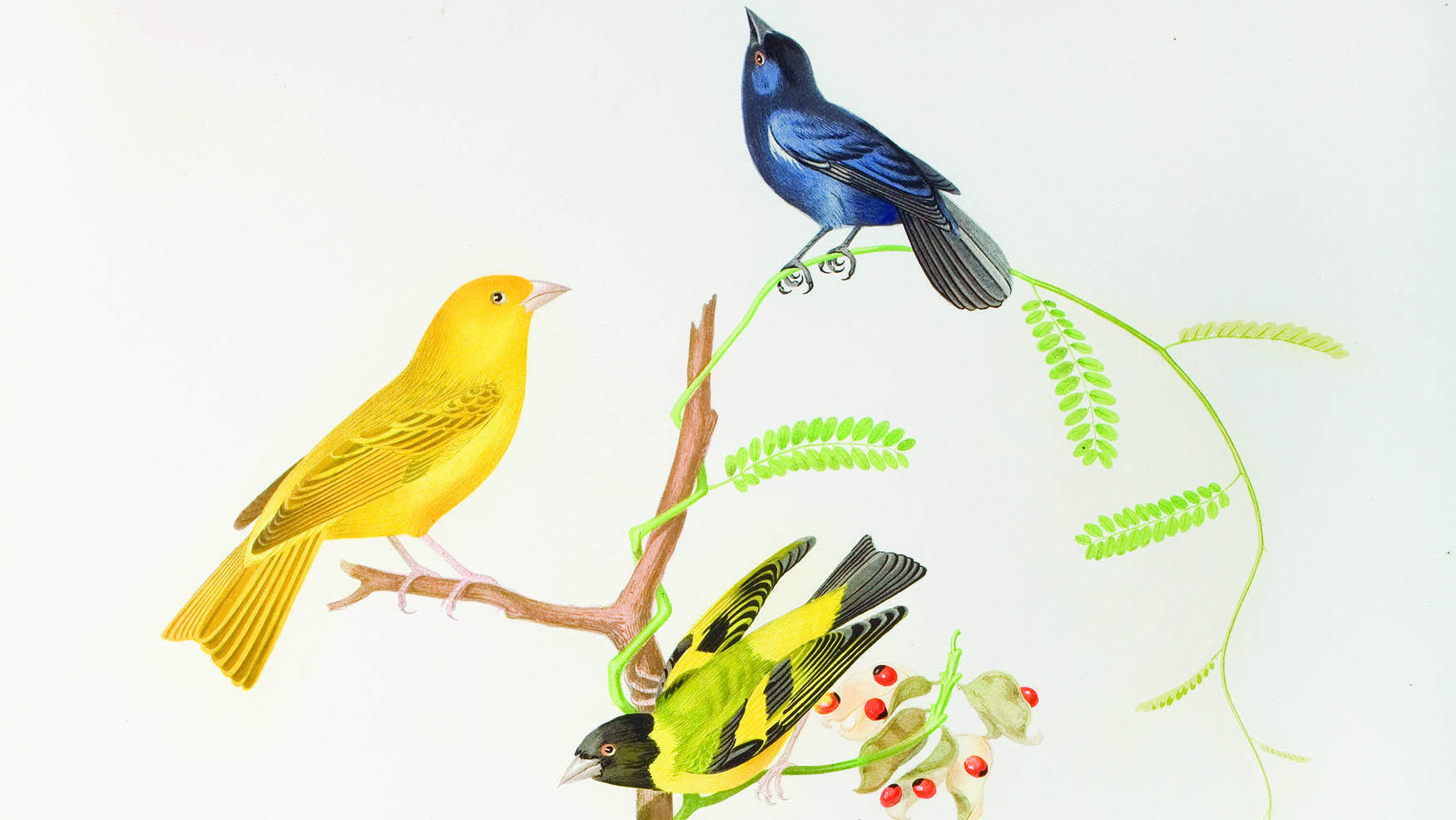
Birds in the New World
Bright green with a red throat and white forehead, the Bahamian subspecies of the Cuban amazon parrot (Leucocephala bahamensis) is now extirpated on the island of San Salvador. But when Christopher Columbus landed there in October 1492, it was still common and was the first land bird he encountered. He was alert to these birds, as well as others he found on the islands of the Caribbean: “The singing of little birds is such that it would seem that man would never wish to leave here; and the flocks of parrots obscured the sun; and big and little birds of all sorts, are so different from ours that it is marvelous” (Morison 1963, 77). One might imagine these exotic birds suggesting to Columbus that he was somewhere entirely unknown; instead, they undoubtedly reinforced his mistaken belief that he had been to “the Islands of India beyond the Ganges,” as reported in the preface to his letter to Ferdinand and Isabella announcing his discoveries, published in 1493. When he returned to Spain and went on procession from Seville to Barcelona in celebration of his discoveries, he carried with him New World parrots in cages. His audiences, though no doubt impressed by the colorful and talkative birds, would have likewise thought the birds came from India. Why? Because as early as 327 B.C., parrots had been captured in India by Alexander and shortly thereafter were introduced to Europe (Boehrer 2004, 1). From that point to the time of Columbus, parrots were invariably understood to be exotics from the East.
Soon, of course, the true nature of the discovery was evident, and birds became one of many natural products exported from the New World to Europe. In 1531 a frigate arrived in France containing three thousand jaguar skins, three hundred live monkeys, and six hundred parrots “which already knew a few words of French” (Levi-Strauss 1992, 82). Accounts of some of the more exotic families of New World birds – toucans and hummingbirds among them – appear in two of the earliest European books about birds, Pierre Belon’s L’histoire de la nature des oyseaux (Paris, 1555) and Conrad Gesner’s Vögelbuch (Zurich, 1557). A French missionary and explorer, Jean de Léry, came to Brazil in 1556 and was the first to describe Neotropical birds in a significant way. Most of chapter 11 of his Histoire d’un voyage fait en la terre du Brésil. . . (La Rochelle, 1578) is devoted to birds, providing a fascinating glimpse into the beliefs of the Indians about them and the many practical uses to which the Indians put them. Two of his plates depict bird-feather ornamentation, and he took down in musical notation a song about the blue-and-yellow macaw. He also relates things he calls “still more amazing”: parrots trained to sing and dance, and to speak in both French and native tongues. Léry concedes, “I could not possibly describe in detail all the birds that can be seen in this land of Brazil. They are not only different in kind from those of our Europe, but are of a wholly different range of colors, such as red, pink, violet, white, ash, and shadings of purple” (Léry 1992, 90). Those he did describe are easily identifiable by modern ornithologists such as Helmut Sick, who declares that Léry “was the first to provide accurate data on the birds of Brazil . . .” (Sick 1993, 27).
Sadly, even before Léry got to Brazil Europeans had begun to visit destruction not only upon the native peoples of the New World, but upon the bird life as well. A famous and tragic encounter that involved both was the siege and destruction of Tenochtitlan, the Aztec capital, in 1521. Within the city were magnificent gardens and a splendid aviary. Cortés described a portion of the aviaries in his second letter to Charles V: “There were also ten pools in which there were kept all the many and varied kinds of water bird found in these parts, all of them domesticated. For the sea birds there were pools of salt water, and for river fowl of fresh water, which was emptied from time to time and filled again from the aqueducts. Each species of bird was fed with the food which it eats when wild, so that those which eat fish were given fish, and those which eat worms, worms, and those which eat maize or smaller grains were likewise given those things. . . . There were three hundred men in charge of these birds who knew no other trade, and there were others who were skilled only in curing sick birds. Above these pools were corridors and balconies, all very finely made, where Mutezuma [sic] came to amuse himself by watching them” (Cortés 1986, 110). Fellow conquistador Bernal Diaz de Castillo added, “I cannot possibly enumerate every kind of bird that was in it or describe its characteristics. There was everything from the royal eagle, smaller kinds of eagles, and other large birds, down to the multi-colored little birds, and those from which they take the fine green feathers they use in their featherwork. These last birds are about the size of our magpies, and here they are called quetzals. There were other birds too which have feathers of five colors: green, red, white, yellow, and blue, but I do not know what they are called. There were parrots with different colored plumage, so many of them that I have forgotten their names. There were also beautifully marked ducks, and bigger ones like them. At the proper season they plucked the feathers of all these birds, which then grew again. All of them were bred in this aviary, and at hatching time the men and women who looked after them would place them on their eggs and clean their nests and feed them, giving each breed of birds its proper food. In the aviary there was a large tank of fresh water, and in it was another type of bird on long stilt-like legs with a red body, wings, and tail. I do not know its name, but in Cuba birds rather like them are called ypiris. Also in this tank there were many other kinds of water bird” (Diaz 1963, 228-29).
During the siege of Tenochtitlan, Cortés set the aviaries afire, immolating the birds: “Although it distressed me, I determined to burn them, for it distresses the enemy very much more; and they showed great grief, as did their allies . . .” (Cortés 1986, 223). This horrid event presages the widespread destruction of habitat by fire that continues to this day. Claude Levi-Strauss’s lament, speaking of the Brazil that awed the early French explorers, applies equally well to the rest of the Neotropics: “What they saw then, no western eyes will see again” (Levi-Strauss 1992, 326).
